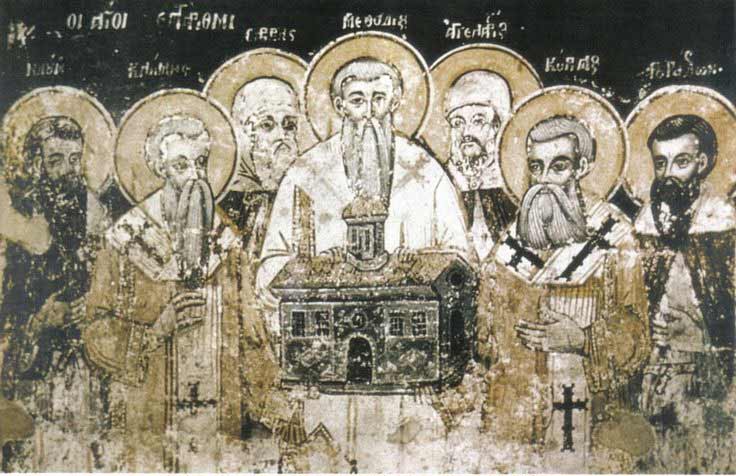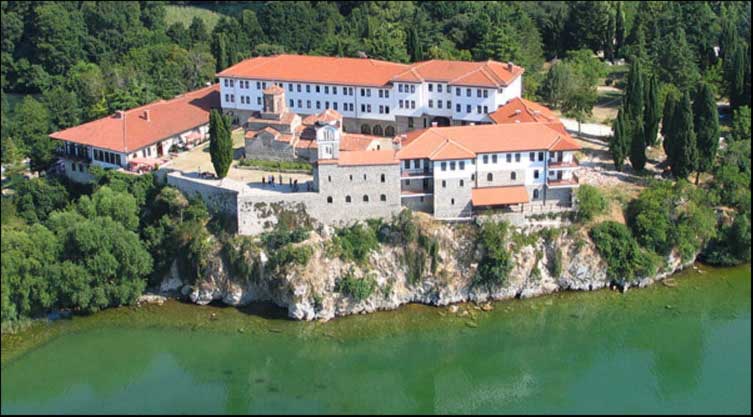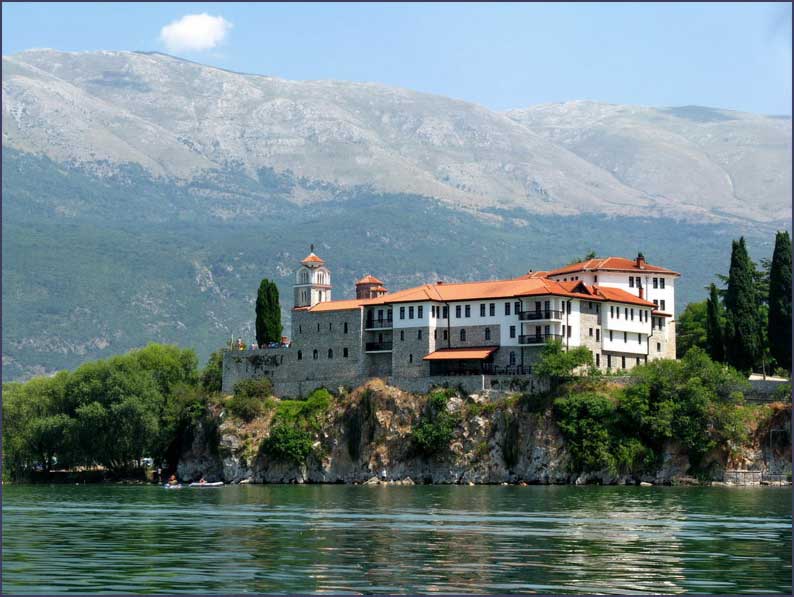On December 25, 1970, by the Julian calendar, and January 5, 1971, by the Gregorian, it was exactly 1060 years since the death of St. Naum Ohridski (St. Naum of Ohrid). After Clement of Ohrid he was the most consistent and worthy of the pupils of the Salonica brothers Cyril and Methodius, a personality who devoted his whole being to the work of establishing Slav literacy and who was one of the founders of the Macedonian Orthodox Church.
For over one thousand years he remained almost unnoticed and uncelebrated, just as he lived in the service of his people and the Church to which he belonged as a modest monk and great educator. The political and socio-religious conditions under which the Macedonian nation lived for much of this period and till recently, did not allow them to pay due tribute to their great men.
The enormous historical importance of the work of Ss. Cyril and Methodius naturally overshadowed the activity of their followers somewhat. Among the latter, however, St. Clement of Ohrid stands apart as the recognized and most authentic continuer of their work, so that the other pupils of the Holy Brothers seem of secondary importance.
This was the historical fate of the great St. Naum of Ohrid as well. His greatness is unquestionable, for after more than ten and a half centuries, the people and national and church history jealously guard his place, figure and role. However, working in the shadow of the Holy Brothers and Clement, St. Naum of Ohrid has always been mentioned in fourth place in order of importance of those who engaged in the far-reaching task of creating Slav literacy and culture.
On the occasion of the 1060th anniversary of his death, the Slav peoples, and above all the Macedonian nation, have a moral and historical duty to express their admiration and gratitude for his work. The reason for this is not simply pious respect, but because the work of St. Naum of Ohrid has been extremely significant in preserving Slavic, and particularly Macedonian, identity. It should also be mentioned that St. Naum was born in Macedonia, that he was active among the Slav peoples of Moravia and Panonia, and that he returned to his native land to spend tile last years of his life in intensive work there, wishing by this to repay debt to his own people in Macedonia.
Just as the Holy Brothers, Cyril and Methodius endured many hardships in their educational-missionary work, so their followers trod the same martyr’s path of suffering. St. Naum of Ohrid was no exception. In fact, from the departure for Moravia in 862 until the deaths of Cyril (869) and Methodius (885), Naum, together with Clement and the other pupils, was inseparable from his teachers. But their most difficult and fateful moment was after the death of Methodius, for, under the influence of German churchmen, the Franks attacked the pupils. And then, in the words of Clement of Ohrid’s biographer:
“Soldiers, stern men because they were Germans and by nature fierce, their fierceness being increased by their orders, took the priests, led them out of the town, pulled off their clothes and began to drag them along naked. Thus by one act they did them two wrongs: dishonored them and tortured them in the icy fog, which had descended on the Danube banks. Besides this, they put their swords against their heads, ready to cut them, and their spears against their breasts, ready to make them bleed, so they would not die a sudden death…”
“Subjected to cruel torture, some of the pupils succumbed, while the others, among them particularly Gorazd, Clement, Naum, Sava and Angelarius, were declared excommunicate by Bishop Vihing. Their books were seized or burnt. The younger pupils (about 200) were sold as slaves, while these five were driven out of the country.”
On the way home to Macedonia, Clement, Naum and Angelarius (who died shortly after), stopped for a short time at Pliska in Bulgaria, at the request of the Bulgarian prince, Boris. There was great interest in them as followers of the Holy Brothers and they were very warmly welcomed here, being asked to stay to continue their educational work. Not wasting any time, Clement and Naum, aware of how much they had lost by the destruction of their books in Moravia, used this short break to write and translate service books from Greek into the Old Slav language.
Against the wishes of Prince Boris that they should remain in Pliska, Clement and Naum tried to set out for their native land as soon as possible. However, when Boris found that he could not hold both, he made the condition that if Clement went, Naum should remain. This was a very painful moment for the two inseparable teachers (some historians even consider that they may have been brothers), but they had no choice: if Clement was to go. Naum had to stay.
Although their biographers have not given us very precise details about the birthplace of Clement and Naum, most historian consider that it was in Macedonia, on the middle reaches of the River Vardar, near its confluence with the Bregalnica, or in the surroundings of Lake Ohrid. This is supported by a number of factors, one of them being their desire to go to Macedonia after the Moravian mission with Cyril and Methodius. Another biographer, however, says only: “That great and good Father Naum grew up in Moesia.” Their Macedonian Slav origin, though, has not so far been questioned.
St. Naum is believed to have been born in 835 and to have been Clement’s inseparable companion from the earliest youth. As disciples of the Holy Brothers, they set out for Moravia together, worked as missionaries and suffered together there, and intended to work together when they returned to Macedonia. It was no wonder, then, that they were greatly moved when the time came for them to part, Clement setting off for Devol-Kutmicevica while Naum remained at Pliska.
At Devol-Kutmicevica, among his own people, Clement successfully continued the educational work of his teachers. Devol, Glavnica and Ohrid, the seat of Clement’s university, soon became centers at which very learned men — deacons and subdeacons, presbyters and monks — gained their education. Thus, this region in Macedonia became a true cradle of Slav education and culture.
And while Clement was engaged in the fruitful work, which earned him the indebtedness of the Macedonians and other Slav nations, his friend Naum was occupied with similar educational activity for which he had become famous in Pliska. In the monastery of St. Panteleimon he managed to gather around him and impart elementary and more advanced knowledge to a large number of young men. He thus became the founder of the famous Preslav educational center in Bulgaria.
In scholarship and ability St. Naum of Ohrid was almost the equal of St. Clement, as can be seem from the fact that Constantine the Philosopher (St. Cyril) chose him, together with Clement, to accompany him to Moravia. Among the large number (over 200) of disciples of Cyril and Methodius, Naum, Clement, Gorazd, Sava and Angelarius were always set apart from the others, both by their teachers and by their enemies. For it is well known that while the rest of the Holy Brothers’ followers were sold as slaves, these five were imprisoned, tortured and finally driven from Moravia. And then came the moment when Clement wanted to leave for Macedonia and when Prince Boris determined to keep Naum:
“Clement long followed in Methodius’ footsteps and acquired his mastery of both preaching and writing in the Slav language. I part from him with sorrow. But his companion Naum will remain with us, and that is some consolation, for Naum is just as much a master of Slav scholarship. And Naum, like an eagle, will gather the young under his wings and continue with them the work already begun.”
When Clement was nominated the first Slav bishop in the Balkans in 893, he made his acceptance of Episcopal office before Prince Simeon (son of Boris) conditional upon Naum’s return to Macedonia:
“Allow Father Naum to come with me (said Clement to Prince Simeon). If it please the Lord, for the good of the people, that I should take up a bishop’s staff, who will continue my teaching at Kutmicevica? Only Naum could do that.”
It is not accidental that St. Naum is referred to during the liturgy by the expression “light of all the people of Moesia”. According to some versions, it is assumed that St. Naum of Ohrid was in fact the author of the work of Crnorizec Hrabar (this view is held by the Czech Slavonic scholar Milosh Vajner and is cited by Blazhe Koneski in his work “The Ohrid Literary School”). It is well known, however, that Hrabar’s apology is the most clearly reasoned defense of Cyril’s work, not only as a continuation of the struggle against trilingualism, but as a protest against the Grecophile party, which aimed to impose its wishes with regard to the alphabet as well as gain control of church life.
During his seven-year stay (885-893) in Pliska, in the monastery of St. Panteleimon, Presbyter Naum managed to make literate and train many young men. He also translated a number of service books from Greek into Slavic. This was very important in view of the Fact that after the death of Methodius, the Franks destroyed all the Slav hooks, which the Holy Brothers and their followers had translated.
In 893, these two great men finally achieved their wish: Prince Simeon was obliged to let Naum go. Naum, now a bishop, returned to Macedonia together with Clement. While Bishop Clement was occupied with his duties of office in the Great Eparchy (thought to have covered the district of Kutmicevica which included, besides Ohrid, Devol and Glavinica, the towns of Kichevo, Prilep, Bitola, Prespa, Meglen, Voden, Kostur, Janina and others), Naum became the head of Clement’s university at Devol.
With the experience he had gained in educational activity during his stay in Moravia and in Bulgaria, Naum was able to replace Clement completely. True, he was now no longer alone. Inseparable since early childhood, Naum and Clement spent the last years of their fruitful hives together. As a result of their work, 3,500 pupils passed through this first Slavic university, whose curriculum was very wide: singing, Slav oratory, translation of books from Greek to Slavic, law, civil and ecclesiastical history, the study of nature, philosophy, medicine, etc.
However, Naum’s health was failing him, so he remained at the head of Clement’s university for only a few years. Wishing to spend the end of his days in peace and prayer, he arranged with Clement for the building of the monastery of the Holy Archangels Michael and Gabriel (now St. Naum of Ohrid). And while Naum was building his monastery at the source of the River Drim, below Mt. Galichica, Bishop Clement was building his — the monastery of St. Panteleimon (now the Imaret) — on the other side of the Lake, in Ohrid. According to the work known as “the second life of Naum”, Presbyter Naum completed his monastery in 905, and Bishop Clement consecrated it.
Shortly after, St. Naum took monastic vows and retired to his monastery, where he spent the rest of his file in peace, solitude and prayer. This act has been linked with the spread of monasticism in Macedonia, for which Naum is considered responsible. Having spent his last years in the service of God and his people, Naum of Ohrid died in his monastery on December 23 (January 5), 910. After the funeral conducted by Bishop Clement, he was buried in the monastery, and the relics of this worthy and great educator have remained there ever since.
When Naum retired to his monastery, Clement transferred the teaching center from Devol to Ohrid. There, under his direct leadership, it continued to expand.
As a mark of his great affection for Naum, Bishop Clement, withdrawing into his monastery, where he spent his last years, wrote a panegyric upon the patrons of Naum’s monastery, the Archangels Michael and Gabriel, which, together with the famous panegyric upon St. Cyril of Salonica, is one of the great treasures inherited from that period.
Clement and Naum’s work and Clement’s university are not simply a continuation of the educational activity of Cyril and Methodius. Following the persecution in Moravia, which led to the destruction of almost all their writings the activity of Clement and Naum meant, in fact, the fulfillment of the mission of bringing enlightenment to the Slavs, or rather, the complete victory of Slav language over the theory of trilingualism. It is to their credit that Ohrid became and remained the “lighthouse” of Slav literacy, a real Slav Jerusalem, as many today consider it.
Many legends have survived about Clement, Naum and the Ohrid of their time. Ohrid was not simply an educational center nor is it just a treasury of great works of art created by human genius throughout the turbulent history of this people; Ohrid is also the place where the relics of these great Slays and Macedonians are preserved. In this way, the people expressed their enduring respect for Naum and Clement and defied the misfortunes that befell them in their history.
When speaking of Clement and Naum, it should certainly not be forgotten that they were the founders of the first Slav-Macedonian bishopric in Ohrid, which preceded the ancient Ohrid Patriarchate and Archbishopric. In the eight centuries of its existence, this institution brought much of benefit and contributed to the preservation of the national spirit of the Macedonian people. This role of the Ohrid Arch-bishopric was of particular importance when the Macedonian people where deprived of their national independence and statehood.
Commemorating the 1060th anniversary of Naum’s death, we recall also the history of the Ohrid Archbishopric, which was abolished in 1767 by Sultan Mustafa III and renewed in 1958 by decision of the Macedonian Church Assembly in Ohrid. In particular we recall July 1967 when in Clement’s town, Ohrid, the Holy Synod proclaimed the Macedonian Orthodox Church autocephalous.
On the anniversary of the death of Naum of Ohrid, the Orthodox of Macedonia and the Macedonian nation are paying due tribute to a great educator. The Holy Synod of the Macedonian Orthodox Church has proclaimed 1971 a jubilee year, and among other events on the program of the Macedonian Archbishopric, there will be the main celebration in Ohrid on July 3, 1971, the feast day of St. Naum’s monastery. There, beside Naum’s tomb, the dignitaries of the Macedonian autocephalous Church, led by Dositej, Archbishop of Ohrid and Macedonia, will conduct services and give visible expression in other ways to the gratitude and respect felt towards the enduring work of St. Naum of Ohrid.

Virtual Macedonia
Republic of Macedonia Home Page
Here at Virtual Macedonia, we love everything about our country, Republic of Macedonia. We focus on topics relating to travel to Macedonia, Macedonian history, Macedonian Language, Macedonian Culture. Our goal is to help people learn more about the "Jewel of the Balkans- Macedonia" - See more at our About Us page.
Leave a comment || Signup for email || Facebook |
History || Culture || Travel || Politics


















God Bless Macedonia and The Macedonian People from The Macedonian problems and move forward with The Proper Solution inside and outside of the homelands. Amen.